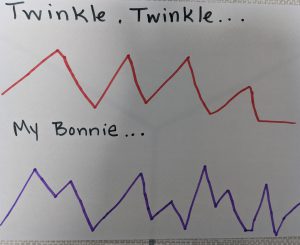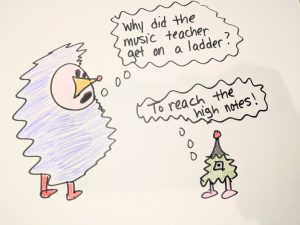December is Pitch Month here at The Jam Cats! Pitch is how high or low a sound is. Smaller instruments generally play higher sounds and larger instruments generally play lower sounds. For example, a piccolo plays very high pitches and is very small. The tuba plays very low pitches and is very large. Think of three bongo drums. The smallest of the three will play the highest pitch, the largest drum will play the lowest pitch, and the medium size drum will play a pitch that is in between the two. On a piano, the further to the right the notes, the shorter the strings inside the instrument and the higher the pitch. Similarly, with a xylophone, the bars are largest on the left, creating lower pitches. These pitches are named using the musical alphabet.
Here, Mr. DJ demos Lollipop Drums. Notice the difference in pitch when he uses a larger drum!
In this video, Mr. Zack shows us the joia tubes. Different sized tubes create different pitches.
There are many ways to teach pitch to appeal to multiple styles and learners and the best way to enforce the concept is to combine all of them. Here are some of my favorite activities to teach pitch.
Spatial
For visual learnings, using pitch to create and study a visual is highly beneficial. This can be done with multiple art mediums (pencil, crayon, paint) and some music. Two (very different) songs I like to use with pitch are Twinkle, Twinkle Little Star and Kangaroos from Camille Saint-Saëns’s Carnival of the Animals. Twinkle, Twinkle is the best to start with, being the most familiar. Choosing a point in the middle of the paper, draw or paint the direction in which the pitch moves as the song plays. Because of the simple pitch, the final drawing becomes steady hills, like a roller coaster, that create an easy visual to show the song’s pitch. Allow the child to do the same. Other familiar songs that work well for this exercise are My Bonnie, Happy Birthday, and Row, Row, Row Your Boat. Once it seems the child has a good grasp on familiar songs, Saint-Saëns’s Kangaroos is a short piece with many “hills and valleys” in pitch.

Aural
WEEEE-OOO! Imagine a fire siren, starting low, emulate the sound! Note that you are changing your “pitch” from the start to the middle to the end of the sound.
Kinesthetic
Using the spatial and aural activities, add arm and body movement. When the pitch is lowest, hands to the ground. As the pitch gets higher, so should your arms. Raise them over your heads! When combined with the sirens, this is my favorite way to introduce the concept of pitch to young children.
Linguistic
When children are older and or have truly grasped the concept of pitch, creating a story that involves elements of pitch is a creative way to drive home the concept. Instruments that are larger will create lower pitches and instruments that are smaller will create higher pitches. Create a story in which there is a large and small non-human character. The story does not need to have an intense plot. It can even be a single picture and scenario the child creates. When reading the story, the larger character has the low pitched voice and the small character has the higher pitch.

Be sure to share with us other songs and activities you use with your children and students and let us know how some of these worked for you!




